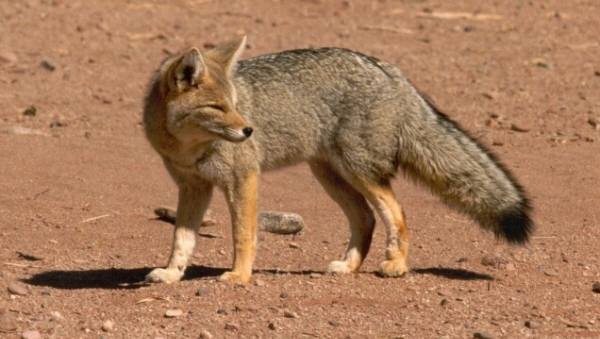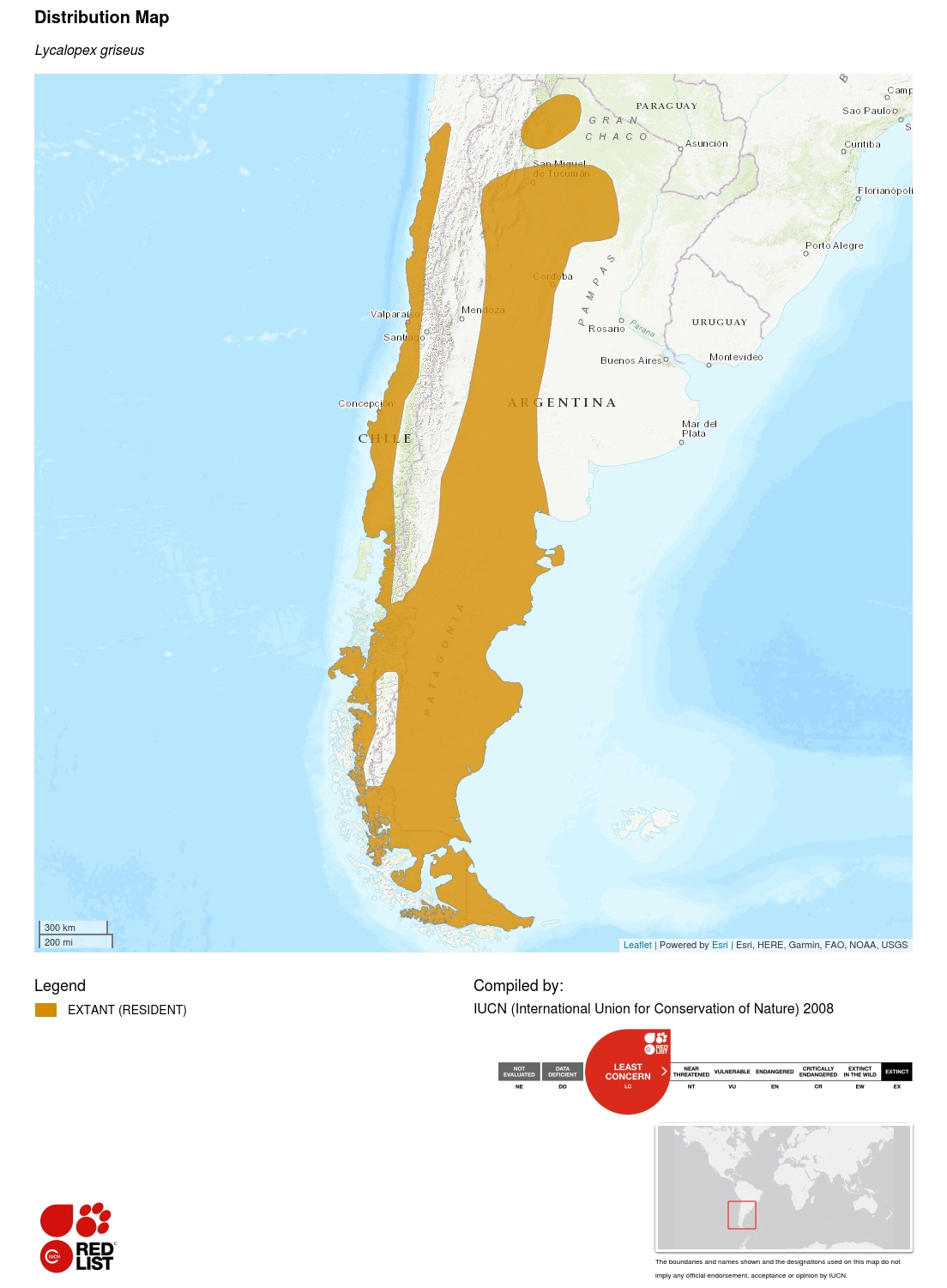
- South America
- Central & North America
- Europe & North/Central Asia
- Sub-Saharan Africa
- North Africa & the Middle East
- South Asia
South AmericaChilla Lycalopex griseus

chilla - © Rafael González
Relevant LinksReports / Papers- 2004 Status Survey & Convervation Action Plan - South America
- El manejo de zorros en la Argentina. Compatibilizando las interacciones entre la ganadería, la caza comercial y la conservación
- Sarcoptic mange: An emerging threat to Chilean wild mammals? (Montecino-Latorre et al. 2020)
Synonym: Pseudalopex griseus
Spanish; Castilian: Chilla, Zorro Chico, Zorro Chilla, Zorro De La Pampa, Zorro Gris, Zorro Gris Chico, Zorro Gris Patagónico
English: Argentine Gray Fox, Grey Zorro, South American Grey Fox
French: Renard Gris
German: Patagonischen Fuchs

Taxonomic Notes
Several recent molecular studies have provided support for a monophyletic assemblage of South American endemic canids (Lindblad-Toh et al. 2005, Perini et al. 2010), with Chrysocyon and Speothos forming a sister-clade to the monophyletic south American foxes and Atelocynus. On the basis of morphology, Zunino et al. (1995) reviewed previous work and also supported clustering species within the two previous paraphyletic genera (Pseudalopex, Lycalopex) into a single monophyletic genus. They further argued that Lycalopex had priority over Pseudalopex, subsequently also supported by Zrzavý et al. (2004: 324). The only outstanding question would have been whether Dusicyon would have been a more appropriate name, since Perini et al. (2010) reported a close relationship between L. culpaeus and Dusicyon. However, we now know that Dusicyon is far outside this clade (Slater et al. 2009, Austin et al. 2013). Based on this evidence, the genus Lycalopex is used over Pseudalopex for all South American foxes, following Wozencraft's (2005) earlier treatment.
Two morphometric studies (Zunino et al. 2005, Prevosti et al. 2013) have suggested that Lycalopex griseus and the Pampas Fox (L. gymnocercus) belong to the same species, with clinal differences in size. However, as Prevosti et al. (2013) note, most genetic studies have not recovered the two species as a monophyletic group (although see Lindblad-Toh et al. 2005). Given the uncertainty, and since both species are in any event assessed as Least Concern, we provisionally continue to recognize Chilla and Pampas Fox as two distinct species, pending further taxonomic investigations.
Justification
The Chilla is widespread in plains and mountains on both sides of the Andes in Chile and Argentina. Populations in the southern half of Argentina, where habitat is more favourable, are essentially stable. Their status in the northern half of the country is unknown. In Chile, they are considered frequent in the north, scarce in central Chile, and common-abundant in the south. It is considered rare in its limited range in Peru. Despite having been overexploited for their fur in the past, and ongoing widespread, unselective hunting in many areas, Chillas do not seem to be decreasing in number. The species is not considered threatened at present.
Geographic Range Information
This species is widespread in plains and mountains on both sides of the Andes, from northern Chile (17°S) down to Tierra del Fuego (54°S).
In Argentina, they occur in the western and southern arid and semi-arid regions of the country, from ca. 23°S (Jujuy and Salta) to Tierra del Fuego, and from the eastern foothills of the Andes mountain range to meridian 66°W, reaching the Atlantic coast (ca. 63°W) south from Río Negro. They are recorded from the following provinces in Argentina: Jujuy (Jayat et al. 1999), Salta (Mares et al. 1996), Tucumán, Catamarca, Santiago del Estero, La Rioja, San Juan, Mendoza, west of San Luis, Neuquén, west of La Pampa, Río Negro, Chubut, Santa Cruz and Tierra del Fuego (Osgood 1943, Olrog and Lucero 1981).
In Chile, the species ranges from the I Administrative Region (Atacama Province) in the north, south to the Strait of Magellan (XII Administrative Region, Magallanes Province) and Tierra del Fuego (Medel and Jaksic 1988, Marquet et al. 1993), and from the western foothills of the Andes mountain range to the Pacific coast (71–73°W). They were introduced to Tierra del Fuego in 1951 in an attempt to control rabbit (Oryctolagus cuniculus) infestation (Jaksic and Yáñez 1983).
Their presence has been confirmed recently for the coast of southern Peru, from Lima to Tacna. The populations from Peru would be separated by the Atacama desert from those in northern Chile (Pacheco et al. 2009, Pacheco 2014).
Other populations have been reported to exist in some of the southern Atlantic islands, including Malvinas/Falklands (Olrog and Lucero 1981), but this requires confirmation.
Population trend:Stable

Population Information
In Argentina, Olrog and Lucero (1981) considered the Chilla to be "locally common". In the latter country, relative abundance of Chillas has been evaluated mainly through the scent stations technique. Data collected in Patagonia and Mendoza from 1989 to 2003 (Funes et al. 2006) suggest that populations are essentially stable in the southern half of Argentina where habitat is more favourable. The decline in fur demand in the 1990s led to increased Chilla densities (Novaro et al. 2004). They are reported to have expanded their distribution in Tierra del Fuego since their introduction (A. Novaro, in González del Solar and Rau 2004); J. Bellati (in González del Solar and Rau 2004) estimated an ecological density of 1 individual/km² in Tierra del Fuego in 1996. A recent increase in population numbers has also been observed in the southern Argentine Patagonia (Travaini et al. 2007). Interspecific competition with the dominant Culpeo appears to have a strong effect on Chilla population dynamics where the two species co-occur (Novaro et al. 2004, Travaini et al. 2007).
Habitat and Ecology Information
The Chilla occurs in steppes, "pampas" (grasslands), and "matorral" (scrublands) (Olrog and Lucero 1981). They generally inhabit plains and low mountains, but they have been reported to occur as high as 3,500–4,000 m (see Marquet et al. 1993, Jayat et al. 1999). Although Chillas occur in a variety of habitats, they prefer shrubby open areas. In central Chile, they hunt more commonly in flat, open patches of low height (1–2 m) scrub than in areas with dense vegetation or ravines. Yet, they do visit ravines, apparently in search of fruit (Jaksic et al. 1980, Jiménez et al. 1996). In southern Chile (Parque Nacional Nahuelbuta), Chillas also prefer open areas to those more dense patches where Darwin's Foxes occur (Jaksic et al. 1990, Jiménez et al. 1990, Medel et al. 1990). Durán et al. (1985) found that in Chilean Patagonia, their typical habitat was the shrubby steppe composed of "coirón" (Festuca spp., Stipa spp.) and "ñires" (Nothofagus antarctica), and that burning and destruction of forests in order to augment the land for sheep farming seems to have been advantageous for Chillas. A similar preference was detected in Parque Nacional Torres del Paine, where 58% of the 12 monitored individuals used matorral shrubland or Nothofagus thicket habitat within their home ranges, more than was expected (Johnson and Franklin 1994b).
Chillas are tolerant to very different climatic regimes from remarkably hot and dry areas, such as the Atacama coastal desert in northern Chile (less than 0 mm average annual rainfall, 22°C mean annual temperature), to the humid regions of the temperate Valdivian forest (2,000 mm average annual rainfall, 12°C mean annual temperature) and the cold Tierra del Fuego (ca. 400 mm average annual rainfall, 7°C mean annual temperature).
Threats Information
Chillas are still hunted (though apparently with much less intensity) in Chilean and Argentinean Patagonia and has been on the increase in recent years (from 2000 to 2003 the number of "grey fox" pelts exported from Argentina increased from 30,263 to 188,997; Funes et al. 2006). Chillas are also perceived as lamb predators by many rural people in Argentina and Chile (Jimenez et al. 1996, Travaini et al. 2000). Consequently, illegal trapping is still widespread in some regions of Chile and Argentina, mainly related to controlling predation.
Use and Trade Information
Chillas have been heavily hunted for their pelts in the past. Ojeda and Mares (1982) report that 5,789,011 pelts were legally exported from Argentina generically labelled as “zorro gris” (grey fox) from 1972 to 1979. However, inferences on the historical rate of Chilla extraction are difficult, since official pelt-export reports apparently conflated data corresponding to three different species, namely the Chilla, the Crab-eating Fox (Cerdocyon thous), and, particularly, the Pampas Fox. Legal exports of Chilla pelts from Argentina markedly decreased from 1980 onwards, and by 1990 only ~33,000 skins were exported. Numbers of fox skins reported exported from Chile are consistently lower than Argentina (see Iriarte and Jaksic 1986 for a review).
Conservation Actions Information
Legislation
Included in CITES – Appendix II.
Resolution 144/83 of the former National Secretary of Natural Resources and Sustainable Development of Argentina categorises this species as "In Danger". Chillas are totally protected in Catamarca, and San Luis, while in the five continental provinces of Patagonia and in Tierra del Fuego, hunting and fur trading are legal (A. Novaro, M. Funes and R. Palacios pers. comm. 2015).
In Chile, the passing of the 1972 furbearer's protection law appears to have curtailed the exports of pelts (Iriarte and Jaksic 1986, Iriarte 2000). Currently, all Chilean populations are protected by law N° 19,473 [1996], except for those from Tierra del Fuego, where it is considered a pest and can be hunted with no limitations (A. Iriarte pers. comm. 2015).
Presence in protected areas
Present in at least six protected areas in central west Argentina. In Chile, the species is present in 30 Wildlife Protected Areas (WPA) from a total of 49 surveyed. However, 40% of those 30 WPAs are smaller than the 115 km² needed to sustain a minimum viable population (500 individuals). Estimates of local extinctions in WPAs from central Chile reach 50% (see Simonetti and Mella 1997). The most important Chilean WPAs in which Chillas occur include: Parque Nacional Lauca, Parque Nacional Puyehue, Parque Nacional Vicente Pérez Rosales, Parque Nacional Torres del Paine.
Presence in captivity
Chillas occur in many zoos of Argentina and Chile, but details of breeding in captivity are not known.
Gaps in knowledge
The need for a deeper understanding of the biology of the Chilla has been repeatedly emphasized by Argentinean as well as by Chilean studies (e.g., Johnson and Franklin 1994a, González del Solar et al. 1997, Travaini et al. 2000). Reliable information is needed especially with regard to those biological aspects required for population management leading to sustainable use and conservation: population-dynamics, incidence of parasites and other diseases, and research on the role of Chillas in small-livestock mortality (Novaro et al. 2004). Finally, a full review of the current known distributional limits of the species would be useful.

